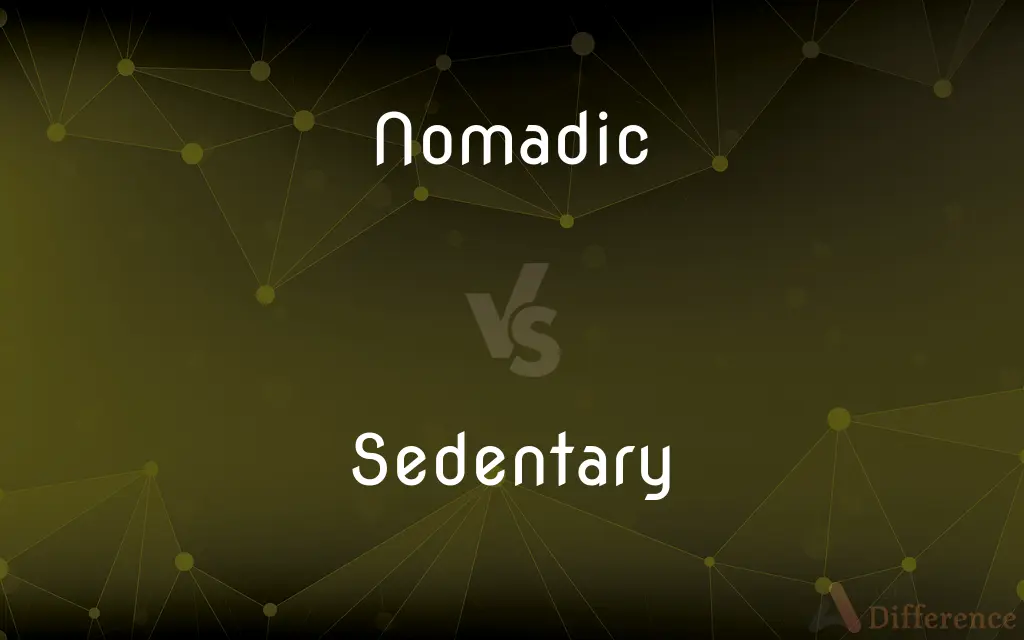Nomadic vs. Sedentary — What's the Difference?
By Tayyaba Rehman & Fiza Rafique — Updated on April 8, 2024
Nomadic lifestyles involve constant movement in search of resources, whereas sedentary lifestyles are characterized by living permanently in one place.

Difference Between Nomadic and Sedentary
Table of Contents
ADVERTISEMENT
Key Differences
Nomadic lifestyles are defined by their mobility, with individuals or groups moving from place to place rather than settling permanently in one location. This lifestyle is often adopted for reasons such as searching for fresh pasture for livestock, hunting and gathering, or trading. Nomads typically have temporary shelters and are known for their ability to adapt to various environments and conditions. On the other hand, sedentary lifestyles involve establishing a permanent residence in a single location, where communities develop agriculture, build permanent structures, and create more complex societal structures, including cities and states. This stability allows for the accumulation of material goods, development of more intricate governance systems, and advancement of culture and technology.
While nomadic societies often rely on pastoral, hunting, and gathering activities for subsistence, sedentary societies depend on agriculture and domestication of animals. The shift from nomadic to sedentary lifestyles marked significant milestones in human history, leading to the development of civilization as we know it. Sedentary living supports larger populations due to more reliable food sources and the storage of surplus goods, whereas nomadic groups are usually smaller, given their need for mobility and the limitations of carrying capacity.
In terms of social structure and cultural development, nomadic groups tend to have fluid and flexible social systems, with traditions and knowledge passed down orally through generations. Sedentary societies, however, have the means to develop written languages, build educational systems, and create enduring works of art and architecture. These differences have led to diverse paths of cultural evolution and historical development.
Despite the stark differences, both lifestyles have adapted to the modern world in various ways. Some nomadic groups have settled into permanent locations due to changes in the environment, political pressures, or economic opportunities, while people living sedentary lifestyles increasingly seek experiences of travel and temporary nomadism, such as through tourism or remote work. The interaction between nomadic and sedentary ways of life continues to shape societies around the globe.
Comparison Chart
Basis of Lifestyle
Movement in search of resources.
Living permanently in one place.
ADVERTISEMENT
Shelter
Temporary and portable.
Permanent structures.
Subsistence
Hunting, gathering, pastoralism.
Agriculture, animal domestication.
Population Size
Generally smaller.
Supports larger populations.
Social Structure
Fluid and adaptable.
More complex and hierarchical.
Cultural Development
Oral traditions, transient art.
Written language, enduring art and architecture.
Compare with Definitions
Nomadic
Lifestyle adapted to the needs of pastoral, hunting, and gathering societies.
Nomadic herders roam vast lands to graze their animals.
Sedentary
Continues to evolve with technology and globalization.
Even sedentary societies seek mobility through technology and travel.
Nomadic
Characterized by moving from place to place without a permanent home.
The nomadic tribe moved to new pastures with the changing seasons.
Sedentary
Living in one location throughout the year.
Sedentary communities rely on agriculture and build permanent homes.
Nomadic
Faces modern challenges such as loss of grazing land and climate change.
Nomadic lifestyles are increasingly threatened by environmental and political changes.
Sedentary
Associated with the development of agriculture and civilization.
The shift to a sedentary lifestyle marked the beginning of agricultural societies.
Nomadic
Often associated with the maintenance of traditional ways of life.
Many nomadic groups maintain rich oral traditions and customs.
Sedentary
Characterized by the creation of permanent works of art and architecture.
Sedentary cultures produced enduring monuments and literature.
Nomadic
Societies known for their adaptability and resilience.
Nomadic cultures have thrived by adapting to diverse environments.
Sedentary
Capable of supporting larger, more complex societies.
Sedentary living allowed for the growth of cities and complex governments.
Nomadic
A member of a group of people who have no fixed home and move according to the seasons from place to place in search of food, water, and grazing land.
Sedentary
Characterized by or requiring much sitting
A sedentary job.
Nomadic
A person with no fixed residence who roams about; a wanderer.
Sedentary
Accustomed to sitting or to taking little exercise.
Nomadic
Of or relating to nomads.
Sedentary
Remaining or living in one area; not migratory
Sedentary caribou herds.
Nomadic
(anthropology) Of or related to itinerant herdsmen.
Sedentary
Attached or rooted; sessile
Sedentary marine organisms.
Nomadic
(figuratively) Of or related to any habitually wandering person or animal.
Sedentary
Not moving; relatively still; staying in the vicinity.
The oyster is a sedentary mollusk; the barnacles are sedentary crustaceans.
Nomadic
Of or pertaining to nomads, or their way of life; wandering; moving from place to place for subsistence; as, a nomadic tribe.
Sedentary
Living in a fixed geographical location; the opposite of nomadic.
Nomadic
(of groups of people) tending to travel and change settlements frequently;
A restless mobile society
The nomadic habits of the Bedouins
Believed the profession of a peregrine typist would have a happy future
Wandering tribes
Sedentary
Not moving much; sitting around.
Sedentary
(obsolete) inactive; motionless; sluggish; tranquil
Sedentary
(obsolete) Caused by long sitting.
Sedentary
A sedentary person
Sedentary
Accustomed to sit much or long; as, a sedentary man.
Sedentary
Characterized by, or requiring, much sitting; as, a sedentary employment; a sedentary life.
Any education that confined itself to sedentary pursuits was essentially imperfect.
Sedentary
Inactive; motionless; sluggish; hence, calm; tranquil.
The soul, considered abstractly from its passions, is of a remiss, sedentary nature.
Sedentary
Caused by long sitting.
Sedentary
Remaining in one place, especially when firmly attached to some object; as, the oyster is a sedentary mollusk; the barnacles are sedentary crustaceans.
Sedentary
Used of persons or actions;
Forced by illness to lead a sedentary life
Common Curiosities
What is a sedentary lifestyle?
A sedentary lifestyle involves living in one location throughout the year, often relying on agriculture and the development of permanent settlements.
What are the social structure differences between nomadic and sedentary societies?
Nomadic societies tend to have fluid and flexible social structures, while sedentary societies develop more complex and hierarchical systems.
How do nomadic and sedentary lifestyles differ in terms of subsistence?
Nomads typically rely on hunting, gathering, and pastoralism, while sedentary people depend on agriculture and domestication of animals.
What defines a nomadic lifestyle?
A nomadic lifestyle is characterized by constant movement from place to place, typically in search of food, pasture, or trade opportunities.
Why did humans shift from nomadic to sedentary lifestyles?
The shift occurred mainly due to the development of agriculture, which allowed for more reliable food sources and the accumulation of surplus goods, leading to larger, more stable communities.
Do sedentary lifestyles offer any advantages over nomadic ones?
Sedentary lifestyles can support larger populations, allow for the development of complex societies, and facilitate cultural and technological advancements.
What challenges do sedentary societies face today?
Challenges include managing resources sustainably, dealing with population growth, and adapting to technological and environmental changes.
Can nomadic societies be large?
Nomadic societies are generally smaller due to the logistical limitations of moving with resources, whereas sedentary societies can support larger populations.
Are there modern examples of nomadic lifestyles?
Yes, there are still groups that lead nomadic lifestyles, such as the Bedouins in the Middle East and the reindeer herders in the Arctic.
How do nomadic and sedentary lifestyles impact cultural development?
Nomadic cultures often preserve traditions through oral history and transient art, whereas sedentary cultures develop written languages, education systems, and permanent architectural and artistic achievements.
How have nomadic lifestyles adapted to the modern world?
Some nomadic groups have settled in permanent locations due to various pressures, while others continue their traditions, adapting to modern challenges.
How do nomadic and sedentary lifestyles influence global culture?
They contribute to the diversity of human experiences, traditions, and perspectives, enriching global culture and understanding.
Can individuals switch between nomadic and sedentary lifestyles?
Yes, individuals and groups may transition between these lifestyles due to economic, environmental, or personal reasons.
How do nomadic and sedentary people view property and land ownership?
Nomadic people often view land as a communal resource to be shared, while sedentary societies typically have concepts of individual or state-owned property.
How does the environment affect nomadic and sedentary lifestyles?
Nomadic lifestyles are highly adaptable to various environments, while sedentary lifestyles may involve altering the environment to meet agricultural and living needs.
Share Your Discovery

Previous Comparison
Adjacent vs. Nonadjacent
Next Comparison
Mesothelium vs. EndotheliumAuthor Spotlight
Written by
Tayyaba RehmanTayyaba Rehman is a distinguished writer, currently serving as a primary contributor to askdifference.com. As a researcher in semantics and etymology, Tayyaba's passion for the complexity of languages and their distinctions has found a perfect home on the platform. Tayyaba delves into the intricacies of language, distinguishing between commonly confused words and phrases, thereby providing clarity for readers worldwide.
Co-written by
Fiza RafiqueFiza Rafique is a skilled content writer at AskDifference.com, where she meticulously refines and enhances written pieces. Drawing from her vast editorial expertise, Fiza ensures clarity, accuracy, and precision in every article. Passionate about language, she continually seeks to elevate the quality of content for readers worldwide.














































